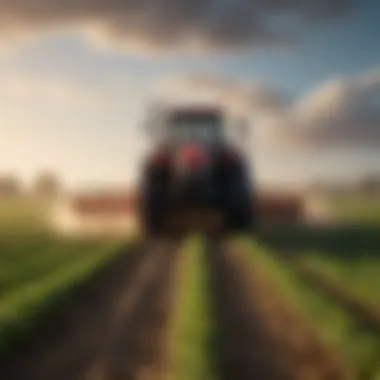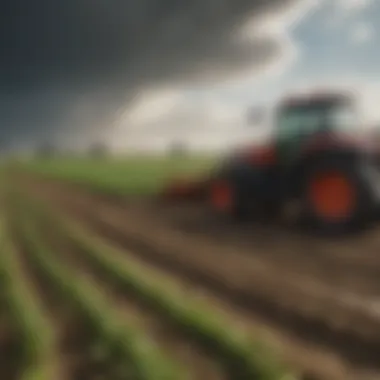Addressing Agricultural Challenges: Insights and Solutions


Overview of the Topic
Definition and Importance
Agriculture is often the backbone of civilizations, providing food, resources, and jobs to countless people across the globe. Today, it's much more than simply tilling soil and planting seeds; it's a complex interplay of technology, environmental considerations, and socio-economic factors. Understanding the importance of modern agriculture is crucial, especially as the world faces pressing challenges like climate change and resource shortages.
Current Trends
Current trends in agriculture indicate a shift towards sustainable practices and innovative solutions. Farmers are now adopting regenerative agriculture techniques, precision farming, and artificial intelligence to optimize yield and minimize environmental impacts. The movement towards organic farming is also gaining momentum, as consumers increasingly demand cleaner and more ethical food options. These trends shape not only agricultural practices but also consumer behaviors and market dynamics, making it essential for stakeholders to be well-informed and adaptable.
Key Techniques and Practices
Step-by-Step Guide
Navigating the complexities of agriculture involves embracing new techniques and practices. Here's a basic guide that farmers might find useful:
- Soil Health Management: Understanding soil composition and its health is key. Farmers can test their soil and amend it accordingly.
- Water Conservation: Implement drip irrigation or rainwater harvesting to make the best use of available freshwater.
- Crop Rotation: Rotate crops to improve soil fertility and reduce pest and disease cycles.
- Integrated Pest Management: Utilize biological pest control methods alongside chemical options to maintain ecological balance.
- Utilization of Technology: Invest in tools like drones for monitoring crops and soil health to optimize farming decisions.
Tools and Equipment Needed
To implement these practices effectively, the following tools and equipment can be essential:
- Soil testing kits
- Irrigation systems (e.g., drip irrigation)
- Drones and satellite imaging
- Comprehensive field mapping software
- Biopesticides and organic fertilizers
Challenges and Solutions
Common Obstacles
Despite the advances in agricultural practices, there are significant challenges that farmers face today. Some of the most common obstacles include:
- Climate Variability: Extreme weather events like droughts and floods disrupt planting and harvesting schedules.
- Regulatory Issues: Navigating local and national regulations can be cumbersome and time-consuming.
- Market Fluctuations: Prices for crops can vary widely, creating uncertainty in profitability.
- Labor Shortage: Finding skilled labor remains a persistent issue, especially in seasonal farming.
Innovative Solutions
Addressing these challenges requires creative and effective solutions. Farmers might look into:
- Implementing Climate Resilient Crops: Breeding or genetically modifying crops that can withstand extreme weather conditions.
- Collaborative Farming Models: Pooling resources and knowledge with other farmers can mitigate risks and enhance profitability.
- Direct-to-Consumer Sales: Establishing farmers' markets or online sales platforms can provide better price earnings by reducing middlemen.
- Flexibility in Operations: Being ready to adapt crop plans based on market trends can help manage the unpredictability of market fluctuations.
"Innovation in agriculture is not just an option but a necessity for those looking to thrive in today's changing landscape."
Intro to Agricultural Issues
Agriculture stands as a linchpin to humanity’s survival, supplying food, fibers, and resources essential for everyday life. As the global population continues to swell, there is an undeniable pressure on agricultural systems to produce more while facing a host of mounting challenges. The importance of this topic cannot be overstated; understanding agricultural issues provides vital insights into ensuring food security, fostering sustainable practices, and addressing broader socio-economic ramifications.
Understanding the Current Landscape
To grasp the myriad of challenges in agriculture, one must first look at the current landscape. The farming industry today is faced with various pressures. For one, climate change alters weather patterns, affecting rainfall and temperature that directly impact crop yields. Farmers in regions that were once fertile now contend with droughts or floods, forcing them to adapt quickly or risk losing their livelihoods. This ever-changing environment requires a nuanced understanding of local ecology, as well as access to technologies designed for resilience.
Moreover, farmers are caught in a web of economic factors that squeeze profit margins. Market fluctuations can hit hard, making it difficult for even the most seasoned farmers to predict their incomes. Additionally, the economic divide is significant; many smallholders struggle to compete with large agribusinesses, which can invest in advanced technology and workforce management. The disparity in resources leads to a significant gap in productivity, which in turn affects consumer prices and food availability.
A crucial element often overlooked is the social aspect of agriculture. Rural communities face myriad challenges, such as youth migration to urban areas in search of better opportunities. This leaves an aging farming population behind, exacerbating labor shortages and decreasing innovative potential. Encouragingly, however, community-led initiatives and cooperatives are emerging, showing that local solutions can address broader challenges.
The Importance of Addressing Agricultural Challenges
Addressing agricultural challenges is fundamental not only for the sustainability of farming practices but also for ensuring global food security. If we fail to tackle these issues head-on, the consequences will ripple through economies and ecosystems alike.
- Food Security: As climate crises and economic stresses grow, the threat to food supplies becomes more critical. Ensuring a reliable food chain is paramount. Any disruptions can trigger global instability.
- Sustainability: By focusing on developing sustainable agricultural practices, we pave the way for a more resilient future. Leveraging innovative methods can reduce reliance on harmful practices and improve soil health, crucial for long-term productivity.
- Community Engagement: Educating and engaging communities in tackling these issues fosters a culture of co-responsibility. Grassroots movements can lead to significant changes in policy and practice, creating environments where sustainable agriculture can flourish.
In summary, a comprehensive understanding and engagement with agricultural issues is not merely beneficial; it’s necessary. Recognizing the complexities of today's agricultural landscape empowers us to advocate for solutions and adaptations that will ensure the industry thrives for generations to come.
Environmental Challenges in Agriculture
Environmental factors play a crucial role in shaping agricultural productivity and sustainability. Farming practices are deeply intertwined with ecosystems, and these connections can enhance or degrade the land and resources upon which agriculture relies. Understanding the environmental challenges is essentially a precondition for effective solutions that address both productivity and ecological balance.
The discussion on environmental issues in agriculture takes several significant aspects into account. Farmers need to grasp the impacts of climatic shifts, soil health, water management, and biodiversity on their practices. When these issues are not addressed properly, they can lead to detrimental effects, not just on yield, but also on our planet's overall health. Here’s a deeper dive:


Climate Change Impacts
Climate change has modified traditional agricultural practices across the globe. Temperature fluctuations, erratic weather patterns, and increasing frequency of natural disasters present substantial hurdles. For instance, rising temperatures can cause heat stress in crops, making it difficult for plants to thrive. Farmers may face unpredictable growing seasons, leaving them guessing when to plant and harvest.
According to the Intergovernmental Panel on Climate Change, predicting these changes is complex, but farmers must adapt. This adaptability can involve switching to more resilient crop varieties, altering planting schedules, and implementing water-saving techniques. Being proactive not only safeguards their livelihood but can reduce their carbon footprint too.
Soil Degradation and Erosion
Healthy soil is the foundation of sustainable agriculture. However, intensive farming practices, coupled with neglecting soil health, contribute to significant erosion and decline in fertility. The high demand for productivity leads to over-tillage, which in turn exposes the soil to wind and water erosion. This cycle can diminish nutrient content and disrupt microbe ecosystems.
Utilizing practices such as cover cropping or no-till farming can greatly be beneficial. These methods not only prevent erosion but also contribute to soil health, allowing crops to flourish year after year. Farmers must recognize that the health of their soil today will determine agricultural success tomorrow.
Water Scarcity and Usage
Water scarcity has become an alarming concern, particularly in arid regions. The competition for water between agricultural and urban settings is intensifying, and with global population growth expected to rise, the demand for water-efficient farming practices cannot be overstated. Inefficient irrigation methods waste precious water resources, leading to both economic loss and environmental stress.
Farmers are encouraged to adopt practices like drip irrigation or rainwater harvesting. Such methods maximize the utility of every drop, ensuring crops have the necessary moisture without depleting the local water table. By embracing these innovations, farming can become more sustainable and cost-effective.
Biodiversity Loss
Biodiversity is not merely an abstract term; it's a vital component of ecosystem resilience. Agriculture heavily relies on a variety of species—not just the crops being grown but also the insects and microorganisms that support them. When monoculture practices dominate, this diversity is compromised. The elimination of natural habitats for agricultural expansion leads to a cascading loss of species crucial for pollination and pest management.
Encouraging biodiversity can be as simple as implementing crop rotation or integrating livestock into crop production. These practices not only promote a richer environment but also enhance the overall resilience of agricultural systems. Moreover, maintaining hedgerows and wildflower strips can provide refuge for beneficial species, effectively creating a more balanced ecosystem.
"Promoting biodiversity isn’t just beneficial; it’s essential for the survival of our agriculture systems."
By dissecting these environmental challenges, we can recognize that the route to sustainable agriculture is multifaceted. Each challenge presents not only obstacles but also opportunities to innovate and adapt. With forethought and strategic planning, farmers can cultivate their lands in harmony with the environment.
Economic Factors Influencing Agriculture
Understanding the economic factors impacting agriculture is crucial in navigating the challenges and identifying the solutions within the sector. The dynamics of the agricultural market can be heavily swayed by a variety of influences such as commodity prices, production costs, and the policies that govern international trade. These elements not only determine the profitability of farms but can also influence food security, rural development, and the sustainability of farming practices. In a world where many aspects of agriculture are intertwined with economics, it’s essential to dissect these factors comprehensively, thereby allowing agricultural professionals and enthusiasts to make informed decisions.
Market Fluctuations and Commodity Prices
Market fluctuations play a significant role in agriculture, often leading farmers to walk a tightrope when it comes to managing their operations. Commodity prices are influenced by several factors, including global demand, weather patterns, and geopolitical events. When prices soar, it can seem like a bonanza; however, high prices can also spur oversupply as more growers enter the fray, leading eventually to sharp price corrections often referred to as a boom and bust cycle. Historially, crop yields vary depending on many externalities, fundamentally changing how farmers strategize their planting and sales.
For example, in the United States, corn and soybean markets often fluctuate seasonally based on the planting cycles. Such volatility can pressure farmers to adapt their strategies in real-time. Additionally, price support programs initiated by governments can also skew natural price dynamics, creating a challenging landscape for independent growers.
Cost of Inputs and Production
Cost considerations are pivotal to long-term viability in agriculture. Input costs—everything from seeds and fertilizers to fuel and labor—can often make or break a farmer’s bottom line. In many instances, prices for essential inputs can rise faster than the income from agricultural sales. This situation leaves farmers in a precarious position, where profit margins are squeezed tighter than a drum.
Take, for instance, the rising cost of fertilizers that has been alarming in recent times; it has forced many growers to reconsider not only how much they use but also which types they rely on. Strategies such as precision farming, which utilizes technology to optimize input usage, are gaining traction as a response to these pressures. Adopting efficient practices can help mitigate high costs, ensuring that farmers remain solvent while navigating the rocky terrain of agricultural economics.
Trade Policies and Global Markets
In today’s interconnected world, agricultural trade policies can have a ripple effect that reaches far beyond national borders. Trade agreements and tariffs can significantly alter market access and profitability for farmers. Farmers must remain acutely aware of international trade dynamics, especially with countries like China and Brazil, who are key players in global agricultural markets. For instance, the shifts resulting from trade wars or tariff changes can either offer new opportunities or impose significant barriers.
If a country imposes tariffs on imported agricultural goods, it compels domestic producers to fill the gap, potentially increasing their revenue. However, it can essentially shut down markets for certain crops that were previously competitive abroad. Understanding these frameworks is critical; it’s not just farmers in one region who feel the impact but rather the global market operating as a cohesive unit.
"In agriculture, the only constant is change—economic conditions, weather patterns, and consumer preferences are always in flux."
To summarize, economic factors are the backbone of agricultural viability. By comprehending market fluctuations, managing production costs, and staying abreast of global trade policies, agriculture professionals can maneuver through challenges effectively. This understanding paves the way for sustainable practices that not only improve yields but also contribute positively to food security and economic stability.
Sustainability Challenges in Agriculture
Sustainability in agriculture serves as the backbone of modern farming. The concept revolves not only around preserving resources but also ensuring that farming practices can produce food without compromising the ecosystem for future generations. Addressing sustainability challenges has become increasingly critical as it influences everything from soil health to the larger global food supply chain. By recognizing these challenges, stakeholders can adapt their actions and create sustainable practices that safeguard both agriculture and the environment.
Agrochemical Usage and Pollution
A significant aspect of sustainability challenges in agriculture is the use of agrochemicals. These chemicals can catalyze increased yields and pest control, yet their persistent use often leads to detrimental environmental consequences. For instance, when fertilizers and pesticides seep into rivers and streams, they contribute to water pollution, harming aquatic ecosystems. This not only disrupts biological systems but can also lead to hazardous drinking water supplies.
The delicate balance between productivity and environmental health comes into focus here. Farmers face the dilemma of improving short-term output without jeopardizing long-term soil fertility and water integrity. Many experts advocate for reducing agrochemical usage by integrating practices like precision agriculture, which utilizes technology to apply only what is needed, when it is needed. This targeted approach can decrease pollution while maintaining productive yields, making it a crucial consideration for sustainable agriculture.
"Sustainable farming practices not only Secured the environment but also generally lead to healthier crop production."
Agricultural Waste Management


Another pressing issue under the umbrella of sustainability is agricultural waste management. It is estimated that a significant percentage of agricultural produce—between 30% to 50%—is often wasted due to poor handling, inadequate infrastructure, or simply being deemed unwanted by consumers. This waste not only represents lost resources but generates methane gas when decomposing, exacerbating climate change.
Effective waste management strategies are essential for turning what typically would be regarded as refuse into resources.
- Composting: Transforming organic waste into nutrient-rich compost can enhance soil health,
- Anaerobic Digestion: This technology captures methane from decomposition, providing renewable energy options while reducing emissions.
- Utilization of Farm Byproducts: Farmers can innovate by finding uses for leftover materials, turning them into feed or alternative products.
With a shift towards more responsible agricultural waste management, we not only reduce pressures on landfills and emissions but also make strides towards a more circular economy in agriculture.
Social and Labor Issues in Agriculture
Social and labor issues play a pivotal role in the functioning and sustainability of the agricultural sector. They affect how farmers operate, the economic viability of their operations, and the social fabric of their communities. Addressing these issues is not just about improving the workplaces; it’s about nurturing the livelihoods of those at the core of food production. Understanding these dynamics is essential for anyone involved or interested in agriculture, be it farming professionals, policy-makers, or enthusiasts.
Labor Shortages and Working Conditions
Labor shortages in agriculture have become a buzzword in recent years, especially in regions heavily reliant on seasonal labor. Factors such as aging population, immigration issues, and urban migration are contributing to this dilemma. Farmers are increasingly finding it harder to find and retain workers who are willing to toil in challenging conditions for low wages. This problem not only leads to financial losses for farmers but also hampers crop yields, resulting in food shortages.
Poor working conditions further exacerbate labor shortages. Many laborers, often migrants, endure long hours without proper facilities or fair wages. This creates a cycle of poor morale and high turnover rates. When workers are dissatisfied, they seek employment elsewhere, leading to the ongoing difficulty of finding dependable hands in fields.
Efforts to improve these conditions can take many forms, from implementing fair wage policies to enhancing workplace safety. Furthermore, incorporating technology, like automated systems or drones, may alleviate some pressure off human labor by streamlining farm operations, although it does present its own set of challenges.
Cultural and Community Impact
Agriculture is not just an industry; it is a community. The cultural impacts of agricultural practices can be profound. Farming methods and the types of crops grown often reflect the traditions and heritage of a community. Unfortunately, as globalization intensifies, local practices can get overshadowed by mass production techniques. This shift can threaten cultural identity and erode communal ties.
Social issues also tie deeply into community welfare. Farmers share stories, resources, and struggles—building a network that is crucial for emotional and economic support. When labor issues predominate or when agricultural practices shift dramatically, these networks can falter. For instance, if a community’s main crop fails due to lack of labor, it creates emotional strain not just for individual farmers, but for the entire community that relies on that crop for economic stability.
Moreover, addressing these social issues head-on can foster a sense of solidarity and rejuvenate local cultures. Engaging community members in decision-making processes surrounding agricultural practices can help ensure sustainability while also honoring local traditions.
"Investing in people is investing in agriculture. Without addressing social concerns, we can hardly hope for a robust agricultural future."
Innovative Solutions to Agricultural Issues
As the agriculture sector grapples with pressing challenges, pinpointing effective solutions becomes dire. Innovative strategies not only address current issues but also pave the way for a more sustainable future. There exist diverse solutions that encompass advanced technology, sustainable practices, and progressive policies. These innovations play a crucial role in enhancing productivity while minimizing environmental footprints.
Technological Advancements in Farming
The integration of technology into agriculture is nothing short of revolutionary. From drones surveying vast crop fields to precision farming techniques using GPS and IoT devices, technology offers practical solutions that simply weren’t available before.
For instance, drones can monitor plant health and assess soil variation over large areas, allowing farmers to make data-driven decisions. Additionally, smart irrigation systems help optimize water usage by analyzing soil moisture levels, ultimately conserving one of our most crucial resources.
Some key benefits of these advancements include:
- Enhanced efficiency: Technological tools streamline operations, reducing labor costs while boosting yield.
- Real-time data access: Farmers can receive immediate insights into their crops, helping them respond quickly to issues as they arise.
These technological strides are game-changers, ensuring farmers can keep pace with the demands of an ever-growing population while maintaining ecological balance.
Sustainable Agricultural Practices
Sustainability is a buzzword that holds enormous weight in today’s agricultural discourse. Sustainable practices emphasize maintaining soil health, reducing chemical usage, and protecting biodiversity.
Some practices include:
- Crop rotation: Regularly changing the types of crops grown, which helps to enhance soil fertility and control pests.
- Cover cropping: Planting cover crops during off-seasons to improve soil structure and prevent erosion.
- Organic farming: Utilizing natural inputs rather than synthetic chemicals fosters healthier ecosystems.
Adopting these methods has benefits that resonate beyond immediate yield. Sustainable practices create an ecosystem where inherently resilient crops thrive, soils regenerate, and farmer livelihoods are more secure in the long run.
Policy Reforms and Agricultural Education
Policy initiatives are essential in cultivating an agricultural landscape that supports innovation and sustainability. Government policies should foster favorable conditions for farmers to adopt new technologies and techniques.
Significant reforms may include:
- Subsidies for adopting sustainable practices: Financial incentives can assist farmers in transitioning to methods that are friendlier to the environment.
- Education and training programs: Providing farmers access to knowledge about modern agriculture can empower them to implement innovative solutions effectively.
Furthermore, increasing collaboration between agricultural organizations, educational institutions, and policymakers can drive a culture of innovation. An educated farmer is undeniably more adept at leveraging new tools and practices, leading to a productive agricultural sector that meets modern demands.
Overall, a focused approach on technological advancements, sustainable practices, and savvy policy reforms can significantly alter the course of agriculture. It’s about creating frameworks that support innovation while respecting the planet and ensuring food security for future generations.


Case Studies of Successful Agricultural Practices
Case studies are like snapshots of what's working in the agricultural field. They offer a lens through which we can observe effective strategies and solutions that have been implemented successfully. When agricultural practitioners, researchers, and investors look at these cases, they gain insights that can lead to innovative practices and more sustainable farming. These studies showcase real-world applications of concepts that range from environmental conservation to economic viability. They act as proof in the pudding; showing that it’s not just theory but practical solutions are in action.
Regenerative Agriculture Models
Regenerative agriculture isn't just a buzzword; it's a holistic approach that seeks to restore and enhance the health of the ecosystem while producing food. This model goes beyond sustainability; it aims to improve soil health, increase biodiversity, and strengthen farm resilience to climate change. In a world where soil degradation is a pressing concern, these models offer hope.
Some important elements of regenerative agriculture include:
- Cover cropping: By planting cover crops, farmers can prevent soil erosion, enhance soil fertility, and improve water retention. Such practices have been shown to reduce the need for synthetic fertilizers.
- Reduced tillage: Less disturbance of the soil helps maintain its structure and health. It’s like giving the earth a break.
- Animal integration: Incorporating livestock into crop systems helps cycle nutrients back into the soil, providing a natural method of fertilization.
A notable example can be found in the Integrated Farm Model employed by certain farms in Argentina. These farms combine crop and livestock operations in a manner that mimics natural ecosystems. Such practices have not only increased their yield but also created a diverse habitat that benefits both crops and livestock, leading to a win-win situation.
I'm certainly convinced that regenerative practices could be key to the future of agriculture, but they require a shift in mindset from merely extracting resources to regrowing them for future generations.
Innovative Crop Rotation Techniques
Crop rotation is another age-old practice that's getting a modern makeover. It's like a well-timed dance, where each crop takes turns on the stage, helping to maintain soil health and protect against pests and diseases.
Here’s how it works:
- Nutrient management: Different plants require different nutrients. By rotating crops, farmers can optimize nutrient use and reduce the reliance on chemical fertilizers. Leguminous crops like beans and peas are often used to fix nitrogen in the soil.
- Pest control: Rotating crops can disrupt the life cycles of pests, making it harder for them to thrive. It’s a straightforward, natural form of pest management.
For instance, farms in Canada have practiced four-year rotation systems that include cereals, legumes, and oilseed crops. This blend of crops not only boosts yield but also significantly improves soil health.
“Healthy soil leads to healthy plants, which leads to healthy food.” This statement resonates loudly in the context of crop rotation.
Overall, these case studies serve as vital illustrations of successful agricultural practices. They show that with a little innovation and some old-fashioned common sense, there are paths forward for sustainable agriculture. The power of collective learning through these cases can guide farmers and stakeholders towards approaches that promote sustainability and resilience in agriculture.
The Future of Agriculture
The future of agriculture is pivotal not just for farmers but for society as a whole. As we stand on the cusp of profound change, it is crucial to recognize how upcoming trends and innovations can shape sustainable food systems. From advanced technologies to collaborative policies, the future promises to bring both challenges and solutions that can enhance productivity and sustainability. This section delves into what we can expect in the coming years and the vital role stakeholders must play in navigating this evolution.
Emerging Trends and Technologies
The agricultural landscape is rapidly changing, driven by several emerging trends and advanced technologies. These developments are aimed at addressing the pressing challenges of yesterday, including resource management, climate adaptation, and food security. Here are some key elements shaping modern agriculture:
- Precision Agriculture: Utilization of satellite imagery, drones, and IoT sensors enhances crop management and helps farmers apply fertilizers and pesticides more efficiently. This level of precision minimizes waste and maximizes yield.
- Vertical Farming: As urban areas continue to expand, vertical farming emerges as a solution to grow food in limited spaces. Utilizing hydroponics and controlled environments, it significantly reduces the carbon footprint associated with traditional farming.
- Biotechnology and CRISPR: Genetic engineering holds great promise for crop resilience and productivity. By altering specific genes, scientists can create varieties that resist pests, tolerate extreme weather, and yield more produce.
- Artificial Intelligence: More than just a buzzword, AI is changing the face of agriculture. AI algorithms can predict crop yields, detect diseases early, and even help in tracking market prices.
These factors not only represent a shift in farming methodologies but also an unmissable opportunity for those willing to adapt.
Global Cooperation and Policy Development
As agriculture transcends national borders, global cooperation becomes essential. Regulatory frameworks and policy developments will significantly influence the sustainability and productivity of agricultural systems worldwide. Here are some considerations for future policy directions:
- Transnational Partnerships: Nations need to collaborate on agricultural research and technology, allowing smallholder farmers access to innovations. Countries that share knowledge and resources can bolster their food security together.
- Sustainable Development Goals: Aligning national policies with international sustainability goals is imperative. This involves integrating environmental stewardship with economic growth, ensuring that agriculture contributes to poverty alleviation without further degrading ecosystems.
- Investment in Research and Education: Governments and organizations should bolster funding for agricultural research. Training farmers on new technologies and practices will empower them to implement effective solutions, promoting a resilient agricultural landscape.
- Inclusive Policies: Stakeholder engagement at all levels – from farmers to consumers – is vital. Policies must be inclusive, addressing the concerns of marginalized communities to ensure food systems are equitable and just.
"In agriculture, change is the only constant. Embracing innovation and collaboration is the way forward to sustain and nourish our growing global population."
Navigating the complexities of agricultural futures requires collective effort and commitment from all parties involved. By understanding these emerging trends and the necessity for global cooperation, a more sustainable agricultural horizon can be achieved.
Ending: A Unified Approach
In the ever-evolving realm of agriculture, stressing unity as a solution is vital. The challenges encountered do not exist in isolation; they are interwoven, demanding a holistic perspective. This conclusion serves as a clarion call to embrace collective efforts aimed at securing a sustainable future.
Integrating Solutions for Sustainable Agriculture
Sustaining agriculture hinges on a multifaceted approach that harmonizes environmental stewardship, economic viability, and social responsibility. It's not just about planting seeds or harvesting crops; it's about embedding sustainability in every practice. To achieve this, a few key strategies include:
- Adopting organic practices: Organic farming enriches the soil and boosts biodiversity. It’s a win-win for farmers looking to meet consumer demand for healthier food while protecting ecosystems.
- Implementing precision agriculture: This approach utilizes technology like drones and satellite imagery to optimize resource use. When farmers know exactly how much water or fertilizer to apply, they can reduce waste and increase yields.
- Promoting agroforestry: Combining trees and crops can lead to improved soil health, increased biodiversity, and reduced erosion. This method not only provides food but also contributes to carbon sequestration.
"Sustainable agriculture is not just a trend; it's a necessary shift for the future of our planet."
These solutions require collaboration among farmers, scientists, and policymakers. By fostering partnerships and sharing knowledge, we can cultivate resilience against external shocks, be it climate-related events or market fluctuations.
Call to Action for Stakeholders
Success in agriculture doesn’t rest solely on the shoulders of farmers. Every stakeholder, from government officials to consumers, has a critical role to play. Engaging these groups is essential to create a sustainable ecosystem. Key actions include:
- Encouraging government policies that support sustainable agricultural practices. This can involve subsidies for farmers who practice eco-friendly methods.
- Promoting educational initiatives targeting young farmers on sustainable farming techniques. Knowledge is power, and equipping the next generation is crucial.
- Fostering community engagement to create local food systems that prioritize fresh, healthy produce. When consumers buy consciously, they not only nourish their communities but also empower farmers.
It’s high time for stakeholders to step up and drive this change. Collaboration across various sectors is paramount, as it aligns efforts and maximizes impact. Let’s come together to navigate the complex agriculture landscape, ensuring a future that fulfills the needs of both people and the planet.



